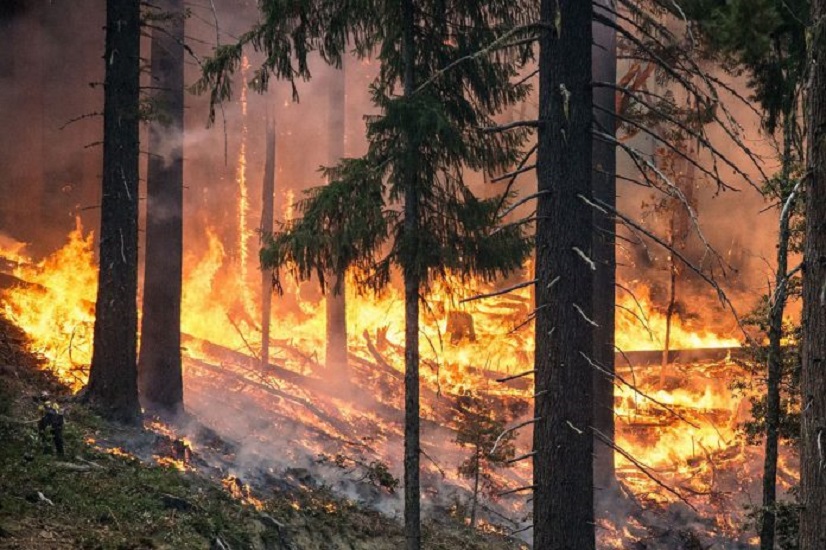
Green Gold Goes Up In Flames, 100 Fire Incidents Reported In 15 Days
Srinagar- As the continuous dry spell in the month of March and April across Jammu and Kashmir flared massive forest fires, a new data has surprisingly brought into fore that there have been more than 100 forest fires in the erstwhile state in the last 15 days.
Even though the majority of the fires were brought under control within several hours by the staff members of the Forest Department and local villagers, experts say, there are serious threats of an existential crisis to the green gold if the dry spell continues.
As per NASA’s Fire Information for Resource Management System (FIRMS) data accessed by Kashmir Observer, in the last 15 days more than 160 fires had raged in the green gold of J&K.
The data notes that most of the forest fires had been recorded in the woods falling under the Jammu region where approximately 70 plus incidents were recorded and most of them took place in Rajouri, Reasi and Udhampur districts.
In Kashmir, the data noted, in the last 15 days most of the forest infernos were recorded in the Uri and Khrew. In Srinagar, there were approximately 9 infernos, 7 in Bandipora, 1 in Ganderbal and 17 in Anantnag.
Pertinently, in the last 24 hours, there have been 14 cases of infernos in J&K, that too, in the forests of Jammu. Three in Udhampur, two near Shaja, two in between Ramnagar and Tawi River, 1 in Katra, 1 near Gool GulabGarh, 2 in Doda and 1 in Bhaderwah, however, in Kashmir region only one forest fire—in Bandipora—has been recorded in the past 24 hours.
It is pertinent to mention here that most of the fire incidents recorded in the past 24 hours are still active.
Notably, several officials of the forest department have said that the unbroken spell of dryness is the main cause of fires spreading at this time of the season.
“However, in most of the cases, we’ve been able to save much of the forest as it is usually the dry grass and bushes that are caught up in the fire.” says Irfan Rasool, Conservator of Forests, North Kashmir.
He further added that the sudden rise in forest fires this year especially in the month of March and April is mainly due to continuous dryness.
“Then there was a record increase in temperature in March and unfortunately less snowfall in the upper reaches during winter is another cause of dryness. The soil in this season would usually be damp, but that’s not the case this year.” Irfan Rasool told Kashmir Observer.
But besides these natural phenomena enraging fires in the green gold, Irfan Rasool says that the man made fires have also damaged the woods.
“People grazing their livestock in these woods usually burn the grass in an attempt to give a chance for the fresh grass to sprout. But, this ground fire quickly spreads and burns down bushes and kairu which is an extremely combustible item. Hence, fire engulfed the whole forest and damaged it within a few minutes.” says Irfan Rasool.
However, with an unprecedented increase in the forest fire, the Jammu and Kashmir administration has established around 250 fire control rooms across the erstwhile state for prevention and control of forest fires triggered by increasing temperatures.
Principal Chief Conservator of forests Mohit Gera said uncontrolled forest fires have not only caused resource degradation but has also contributed to global warming and climate change.
“The incidences of forest fires are increasing due to rising temperatures and dry conditions prevailing in J&K and most of the fires are triggered by human error. Hence, the forest department has established around 250 fire control rooms across J&K and involved PRIs and local people in prevention and control of forest fires.” Gera said.
Follow this link to join our WhatsApp group: Join Now
Be Part of Quality Journalism |
Quality journalism takes a lot of time, money and hard work to produce and despite all the hardships we still do it. Our reporters and editors are working overtime in Kashmir and beyond to cover what you care about, break big stories, and expose injustices that can change lives. Today more people are reading Kashmir Observer than ever, but only a handful are paying while advertising revenues are falling fast. |
| ACT NOW |
| MONTHLY | Rs 100 | |
| YEARLY | Rs 1000 | |
| LIFETIME | Rs 10000 | |










